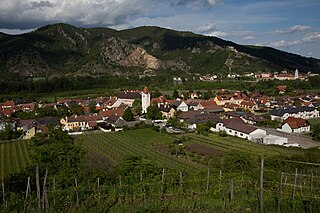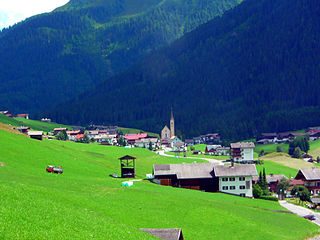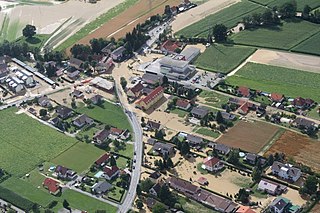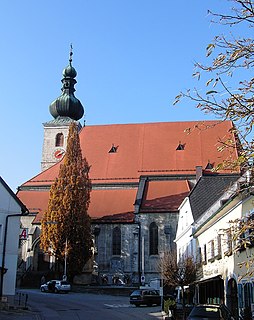
Fulpmes is a market town and a municipality in Stubaital, Tyrol, Austria. In 2015 it had a population of 4,250, of whom 14.5% did not have Austrian nationality. Fulpmes is the center of iron production in the area, and lies at the base of the Schlick 2000 ski area.

Krems in Kärnten is a municipality in the district of Spittal an der Drau in Carinthia in Austria.

Furth bei Göttweig is a town and municipality in the district of Krems-Land in the Austrian state of Lower Austria. The municipality consists of the following populated places:
Rohrendorf bei Krems is a municipality in the district of Krems-Land in the Austrian state of Lower Austria.

Rossatz-Arnsdorf is a town in the district of Krems-Land in the Austrian state of Lower Austria. It is located in the Wachau valley of the Danube, a popular destination for tourists, and has excellent views of the ruins of castle Dürnstein, where King Richard the Lion-Heart of England was held captive by Duke Leopold V.

Senftenberg is a town in the district of Krems-Land in the Austrian state of Lower Austria.

Gießhübl is a town in the district of Mödling in the Austrian state of Lower Austria. It is located in the south of Vienna, the Austrian capital, neighboring the nature protection area Föhrenberge. With an altitude of 416 m, Gießhübl is the highest-located wine-growing district in Lower Austria. Originally Gießhübl was an agrarian village. Today it is mainly a residential area because of its vicinity to Vienna and the direct connection to the highway A21.

Kartitsch is a municipality in the district of Lienz in the Austrian state of Tyrol.
Leutasch is a municipality in the northern part of the district Innsbruck-Land in the Austrian state of Tyrol about 30 km northwest of Innsbruck and 10 km northwest of Seefeld in Tirol

Steinbach an der Steyr is a municipality in the district of Kirchdorf an der Krems in the Austrian state of Upper Austria.

Wartberg an der Krems is a municipality in the district of Kirchdorf an der Krems in the Austrian state of Upper Austria.

Neuhofen an der Krems is a municipality in the district Linz-Land in the Austrian state of Upper Austria.

Adlwang is a municipality in the district of Steyr-Land in the Austrian state of Upper Austria.

Aschach an der Steyr is a municipality in the district of Steyr-Land in the Austrian state of Upper Austria.

Rohr im Kremstal is a municipality in the district of Steyr-Land in the Austrian state of Upper Austria.

Sierning is a municipality in the district of Steyr-Land in the Austrian state of Upper Austria.

Ternberg is a municipality in the district of Steyr-Land in the Austrian state of Upper Austria.
Weyer is a municipality in the district of Steyr-Land in the Austrian state of Upper Austria.

The geology of Surrey is dominated by sedimentary strata from the Cretaceous, overlaid by clay and superficial deposits from the Cenozoic.

Glaciofluvial deposits or Glacio-fluvial sediments consist of boulders, gravel, sand, silt and clay from ice sheets or glaciers. They are transported, sorted and deposited by streams of water. The deposits are formed beside, below or downstream from the ice. They include kames, kame terraces and eskers formed in ice contact and outwash fans and outwash plains below the ice margin. Typically the outwash sediment is carried by fast and turbulent fluvio-glacial meltwater streams, but occasionally it is carried by catastrophic outburst floods. Larger elements such as boulders and gravel are deposited nearer to the ice margin, while finer elements are carried farther, sometimes into lakes or the ocean. The sediments are sorted by fluvial processes. They differ from glacial till, which is moved and deposited by the ice of the glacier, and is unsorted.




















